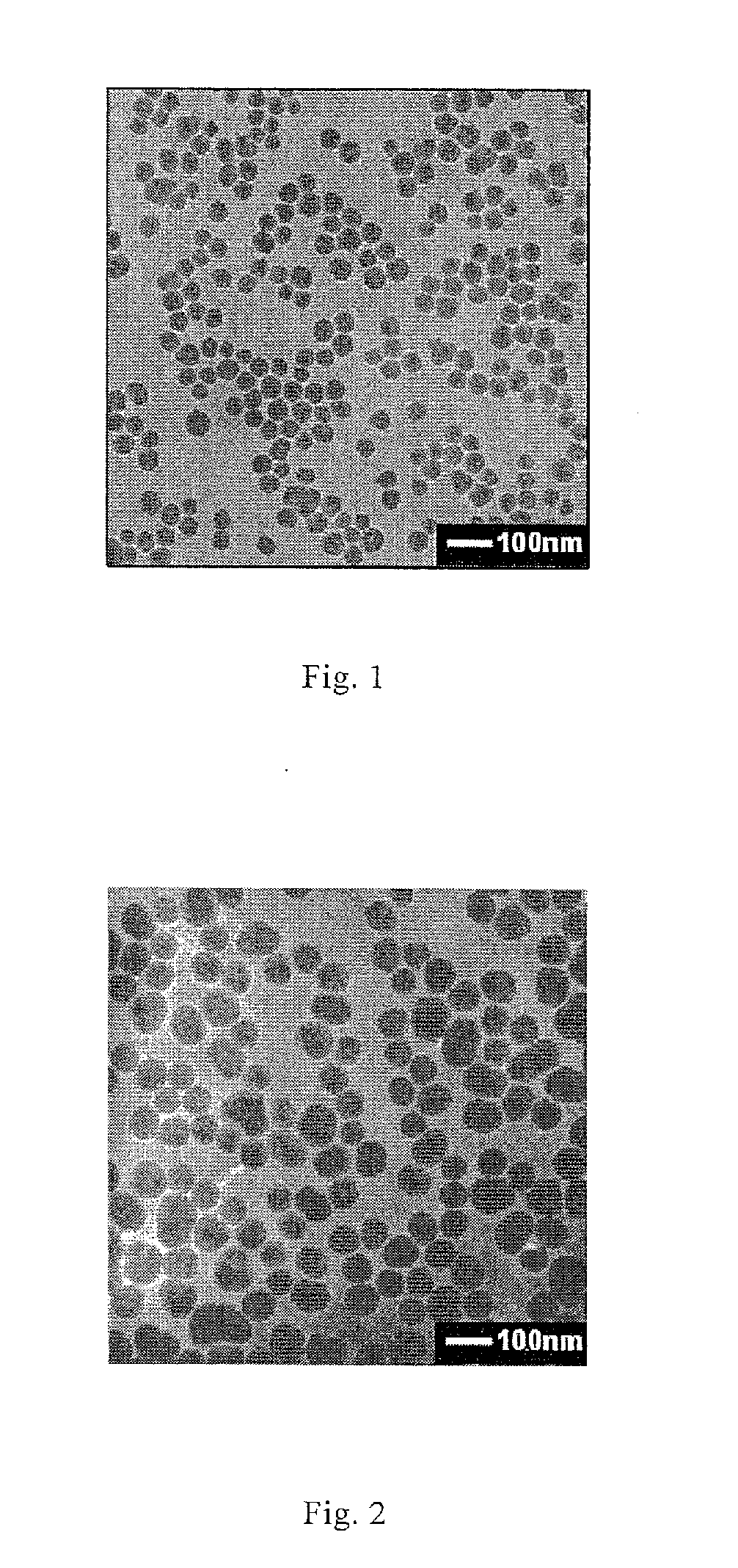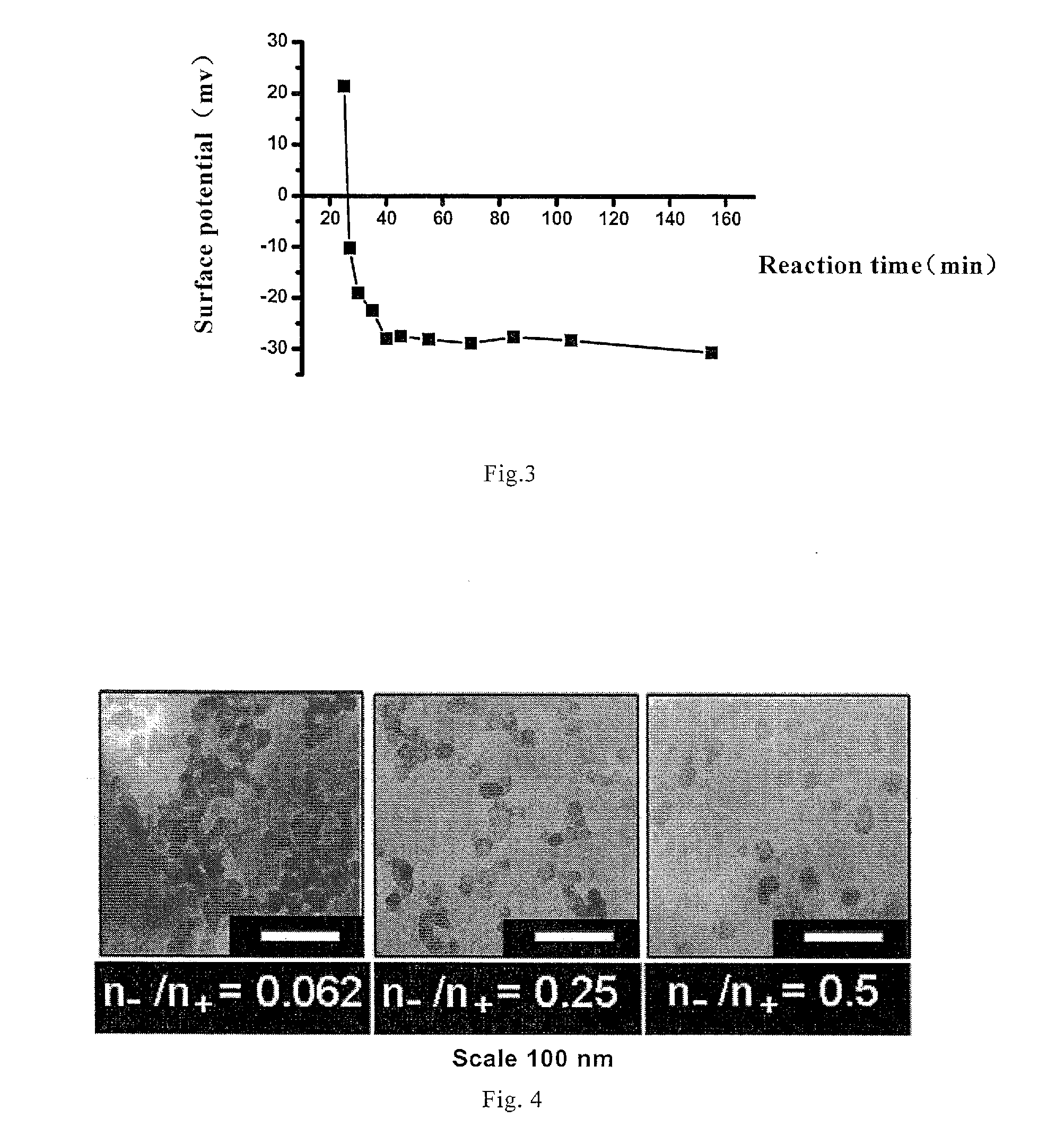Silica Nanoparticles Doped with Dye Having Negative Charge and Preparing Method Thereof
a technology of negatively charged dye and nanoparticles, which is applied in the field ofluminescent nanomaterials, can solve the problems of reducing the types of doped dyes to a limited number, not universally applicable, and methods that are not suitable for negatively charged dyes, so as to achieve the effect of reducing pka, preventing leakage effectively, and completely avoiding leakage problems
- Summary
- Abstract
- Description
- Claims
- Application Information
AI Technical Summary
Benefits of technology
Problems solved by technology
Method used
Image
Examples
example 1
[0067]0.5 ml ethanol / water mixture (ratio of ethanol to water is 8), 4 ml ethanol and 100 μl PDADMAC aqueous solution (molecular weight is 100,000-200,000 Da) with a concentration of 10 mg / ml are added into a 20 ml glass bottle, and 400 μl HPTS aqueous solution (1 mg / ml) is added while magnetic stirring (at a speed of 500 rpm), the stirring is lasted for 20 minutes to obtain a composite solution of polyelectrolyte and fluorescent dye; 8.4 ml ethanol, 815 μl water and 0.1 ml ammonia water are added into another 20 ml glass bottle, and then 300 μl TEOS is added at magnetic stirring speed of 200 rpm and timing is started. After 25 minutes, 1 ml composite solution of polyelectrolyte and fluorescent dye is added into Stöber system quickly, the magnetic stirring speed is adjusted to 50 rpm when it becomes homogeneous, and the reaction continues till the total reaction time reaches 24 hours. The obtained spherical silica nanoparticles doped with HPTS are uniform with average particle size ...
example 2
[0069]2.3 ml ethanol / water mixture (ratio of ethanol to water is 8), 2.4 ml ethanol and 100 μl PDADMAC aqueous solution (molecular weight is 100,000-200,000 Da) with a concentration of 10 mg / ml are added into a 20 ml glass bottle, and 200 μl HPTS aqueous solution (1 mg / ml) is added while magnetic stirring (at a speed of 500 rpm), the stirring is lasted for 20 minutes to obtain a composite solution of polyelectrolyte and fluorescent dye; 8.4 ml ethanol, 815 μl water and 0.1 ml ammonia water are added into another 20 ml glass bottle, and then 300 μl TEOS is added at magnetic stirring speed of 200 rpm and timing is started. After 25 minutes, 1 ml composite solution of polyelectrolyte and fluorescent dye is added into Stöber system quickly, the magnetic stirring speed is adjusted to 50 rpm when it becomes homogeneous, and the reaction continues till the total reaction time reaches 24 hours. The obtained spherical silica nanoparticles doped with HPTS are uniform with average particle siz...
example 3
[0070]3.2 ml ethanol / water mixture (ratio of ethanol to water is 8), 1.6 ml ethanol and 100 μl PDADMAC aqueous solution (molecular weight is 100,000-200,000 Da) with a concentration of 10 mg / ml are added into a 20 ml glass bottle, and 100 μl HPTS aqueous solution (1 mg / ml) is added while magnetic stirring (at a speed of 500 rpm), the stirring is lasted for 20 minutes to obtain a composite solution of polyelectrolyte and fluorescent dye; 8.4 ml ethanol, 815 μl water and 0.1 ml ammonia water are added into another 20 ml glass bottle, and then 300 μl TEOS is added at magnetic stirring speed of 200 rpm and timing is started. After 25 minutes, 1 ml composite solution of polyelectrolyte and fluorescent dye is added into Stöber system quickly, the magnetic stirring speed is adjusted to 50 rpm when it becomes homogeneous, and the reaction continues till the total reaction time reaches 24 hours.
PUM
| Property | Measurement | Unit |
|---|---|---|
| mass concentration | aaaaa | aaaaa |
| molecular weight | aaaaa | aaaaa |
| mass concentration | aaaaa | aaaaa |
Abstract
Description
Claims
Application Information
 Login to View More
Login to View More - R&D
- Intellectual Property
- Life Sciences
- Materials
- Tech Scout
- Unparalleled Data Quality
- Higher Quality Content
- 60% Fewer Hallucinations
Browse by: Latest US Patents, China's latest patents, Technical Efficacy Thesaurus, Application Domain, Technology Topic, Popular Technical Reports.
© 2025 PatSnap. All rights reserved.Legal|Privacy policy|Modern Slavery Act Transparency Statement|Sitemap|About US| Contact US: help@patsnap.com



